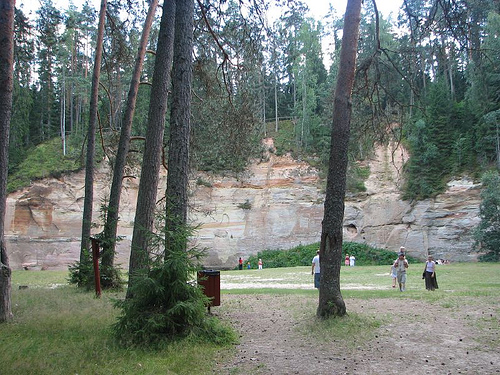

Location: Põlva County Map
Official site
The Taevaskoja Sandstone Cliffs, often referred to as the Large (Suur Taevaskoda) and Small (Väike Taevaskoda) Heaven's Halls, are among Estonia's most iconic natural landmarks. Located in southern Estonia, these dramatic sandstone outcrops rise along the banks of the Ahja River, offering a stunning blend of geological wonder, cultural significance, and scenic beauty. Frequently hailed as one of the country's greatest natural sights, the cliffs attract hikers, nature enthusiasts, and cultural explorers year-round, with every Estonian said to visit at least once in their lifetime.
Taevaskoja is situated in Põlva County, within the village of Taevaskoja in southern Estonia. The cliffs are nestled along the steep, winding banks of the Ahja River, part of the Ahja River Primeval Valley Landscape Protection Area, established in 1957. This protected reserve spans a picturesque ancient valley, with the main outcrops accessible from Saesaare parkla in Taevaskoja küla, Põlva vald. The area is approximately 700 meters from the Taevaskoja Holiday Centre and serves as a gateway to broader explorations in southern Estonia's natural landscapes. The Ahja River itself is a popular waterway for canoeing and kayaking, enhancing the site's accessibility and appeal.
Geologically, the Taevaskoja cliffs are Devonian sandstone outcrops,
formed approximately 419–359 million years ago during the Devonian
period, with some sources noting influences from ancient fluvial
environments over 360 million years old. The Large Taevaskoda (Suur
Taevaskoda) is the most prominent, forming an almost 150-meter-long wall
that rises up to 22.5 meters above the river surface, with a total
relative height reaching 38 meters. It features intertwined layers from
the Härma formation of the Burtnieki stage, displaying a vibrant,
colorful pattern of yellowish, greyish, pinkish-white, and
purplish-brown sandstone strata.
The Small Taevaskoda (Väike
Taevaskoda) is shorter, up to 13 meters high, and includes the
Neitsikoobas (Virgin's Cave), a natural cavity carved by springs seeping
from the porous sandstone. Erosion by the Ahja River has sculpted these
vertical cliffs, creating steep, picturesque formations. The site's
paleontological value is notable, with some references to ancient river
deposits dating back 75 million years to the Late Cretaceous, though the
primary formations are Devonian. Springs at the base, such as the
Emaläte (Mother's Spring), add to the dynamic landscape, where water
continually shapes the rock.
Historically, Taevaskoja has been a site of cultural and spiritual
importance. The name "Taevaskoda" translates to "Heaven's Hall" or
"Sacred Grove," believed to stem from ancient Estonians who worshipped
the god Taara and held gatherings there. It served as a sacred site for
pagan rituals and later as a hideout for the Forest Brothers, Estonia's
legendary resistance fighters during the Soviet era. Traces of Soviet
history, including electrification efforts, are embedded in the
landscape. The cliffs gained modern fame as a filming location for the
1969 Estonian cult film Viimne reliikvia (The Last Relic), particularly
around the Small Taevaskoda.
Legends abound, adding a mystical layer.
One tale describes the Vanapagan (Old Devil) being enchanted by the
site's beauty and building underground rooms, dubbing them the Heaven's
Halls. Another involves a boulder called Nõiakivi (Witch’s Stone) or
Salakuulaja kivi (Spy’s Stone), where an enemy spy was turned to stone
for eavesdropping on folk leaders. Stories of caves, secret passageways,
demons, and a mermaid with a golden comb further enrich the folklore. In
the past, visitors carved names into the cliffs, though this practice
violated nature protection laws and has largely been eroded away by
water.
Key attractions include the Large and Small Taevaskoda outcrops, the
Neitsikoobas cave, the Emaläte spring, and the surrounding primeval
valley. The area offers water-based activities like kayaking, canoeing,
SUP boarding, and even walking along the riverbed. Beyond the cliffs,
visitors can explore broader natural wonders, making it a hub for
geotourism.
Hiking trails are abundant and cater to various levels. A
popular route starts at the Saesaare dam, winding past the Small
Taevaskoda, Emaläte spring, Neitsikoobas cave, and up to the Large
Taevaskoda—a scenic loop ideal for all seasons. Trails vary in length
and difficulty, offering panoramic views of the forest, river, and
cliffs. The site's integration of stone and woodland creates a dynamic
hiking experience, with paths that reveal the area's geological and
cultural layers.
The site is open year-round, with peak access from April 1 to October 31, and is free to visit 24/7. It's highly popular, often described as a must-see for its blend of nature, history, and folklore. Local experts offer personalized experiences, and accommodations like the Taevaskoja Holiday Centre are nearby. As part of a protected reserve, visitors are encouraged to respect conservation rules—no carving or damaging the cliffs. To fully appreciate Taevaskoja, plan for more than a day, combining hikes with river adventures for an immersive encounter with Estonia's natural and cultural heritage.